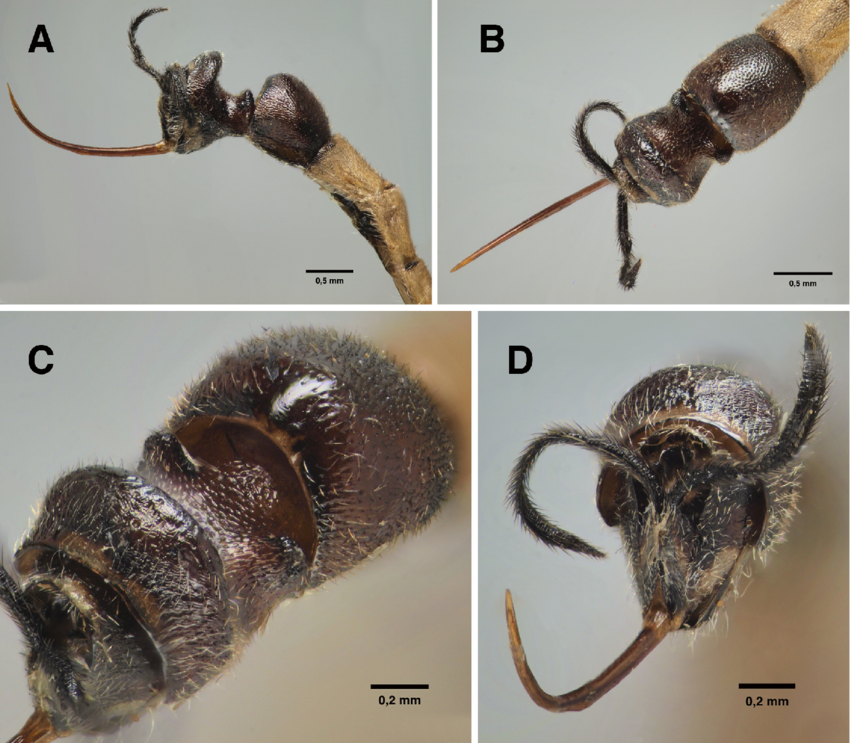The Clistopyga crassicaudata, often referred to as the giant stinger wasp or scorpion wasp, is a newly discovered species that inhabits the transitional zone between the Andean mountains and the lowland Amazon rainforest. Found mainly in countries like Colombia, Ecuador, Bolivia, and Peru, this parasitoid wasp has captured the attention of scientists due to its unique biology and lethal capabilities. Discovered in 2018 by a team of researchers from the University of Turku in Finland, along with Latin American colleagues, this wasp exhibits remarkable features that set it apart from others in the vast family of Ichneumonidae.

Clistopyga crassicaudata belongs to the family Ichneumonidae, a large group of parasitoid wasps. This family is notable for the distinctive second recurrent vein on their anterior wings. Like other parasitoid wasps, it does not directly consume its host but instead uses it as a living incubator and food source for its offspring.
The wasp’s most striking physical feature is its long, thick ovipositor, commonly referred to as a stinger. This organ is dual-purpose: it injects venom to paralyze prey and serves as a tool to deposit eggs into or onto the host. C. crassicaudata typically lays its eggs in spiders or spider egg sacs hidden within tree cavities, allowing the wasp larvae to consume the paralyzed host as they develop.
While there are over 50,000 species of parasitoid wasps in the order Hymenoptera, Clistopyga crassicaudata stands out due to the lethal precision with which it attacks its host. The species is an idiobiont, meaning it paralyzes the host to manipulate it for its own purposes, eventually leading to the host's death. Unlike purely parasitic insects, which may coexist with a host for extended periods, C. crassicaudata quickly incapacitates and consumes its prey.
The venom delivered through its ovipositor is potent, paralyzing the spider or its eggs before the wasp deposits its own eggs. The wasp larvae then feed on the immobilized spider or its developing offspring, ensuring a rich food source as they grow. This process, while lethal for the spider, showcases the remarkable adaptations parasitoid wasps have evolved to survive.
The discovery of Clistopyga crassicaudata in 2018 marked an important addition to the growing body of research on parasitoid wasps. Researchers, including Professor Ilari E. Saaksjarvi and his team, were the first to describe this species, noting its unusually large stinger. While not the largest wasp—an honor belonging to the Asian giant hornet (Vespa mandarinia)—the C. crassicaudata is remarkable for having one of the longest ovipositors among wasps in the Ichneumonidae family.
Due to its recent discovery, detailed information about the behavior, population, and ecological impact of C. crassicaudata is still limited. However, ongoing studies continue to shed light on its role in controlling spider populations in its native habitat.
Understanding the sting mechanism of the Clistopyga crassicaudata also highlights key differences between wasps and bees. While bees possess a barbed stinger that becomes lodged in the skin of their victim—often resulting in the bee’s death—wasps like C. crassicaudata have a smooth, retractable stinger. This allows them to sting multiple times without harming themselves, making them more efficient predators and defenders.
Bee stings, primarily associated with their defense of the hive, serve a different purpose compared to wasp stings, which are often used for hunting and reproduction. While both can inject venom, the smooth stinger of the wasp enables repeated stings, particularly useful in subduing prey or defending against threats.
Clistopyga crassicaudata plays a crucial role in the ecosystem by helping regulate spider populations. Spiders are important predators in many ecosystems, but unchecked, their populations could grow too large. The wasp’s parasitic behavior naturally keeps spider numbers in balance, maintaining a healthy ecological equilibrium.
Though often misunderstood or feared due to their parasitic nature, wasps like C. crassicaudata provide essential services to their environments. By preying on spiders, they contribute to biodiversity and prevent the dominance of any one species, thus supporting the complex web of life in tropical rainforests.
The giant stinger wasp, Clistopyga crassicaudata, represents a fascinating example of parasitoid behavior in the wild. Its discovery in 2018 opened new avenues of research into the diversity and evolutionary adaptations of parasitoid wasps, particularly in South America’s tropical rainforests. With its lethal sting, precise hunting techniques, and specialized role in parasitizing spiders, this wasp is both a marvel of nature and a vital component of its ecosystem. As further research is conducted, we will continue to learn more about this intriguing species and its role in maintaining the balance of life in one of the world’s most biodiverse regions.
animal tags: Clistopyga-crassicaudata
We created this article in conjunction with AI technology, then made sure it was fact-checked and edited by a Animals Top editor.